Apple MacBook Pro 13: Can a Mac Be a Decent Windows Laptop?
by Vivek Gowri on October 14, 2010 9:00 PM ESTApple MacBook Pro 13—Core 2 Duo Performance
It’s kind of embarrassing to be reviewing a $1200 computer with a two year old processor and application performance to match. It’s not that evident in day to day use, and in most games performance is more dependant on the graphics card, but application performance benchmarks are where the Core 2 Duo really makes itself felt (and not in a good way).
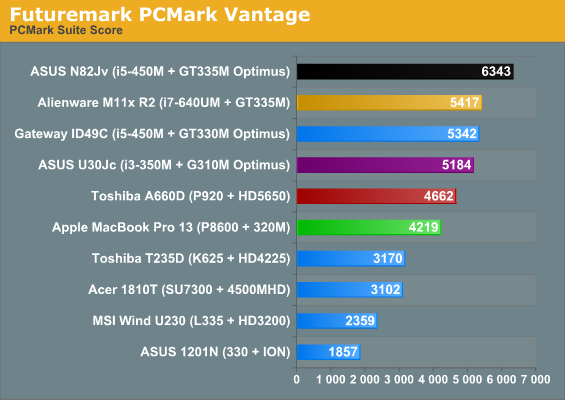
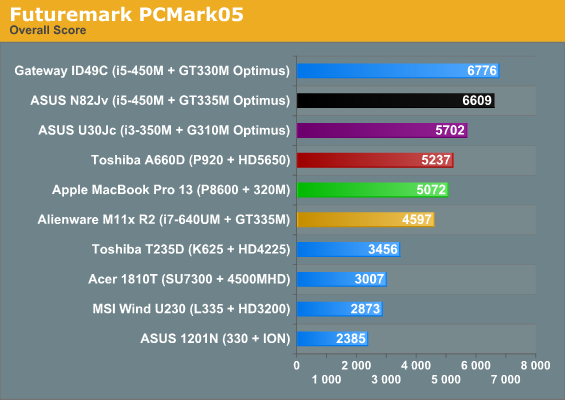
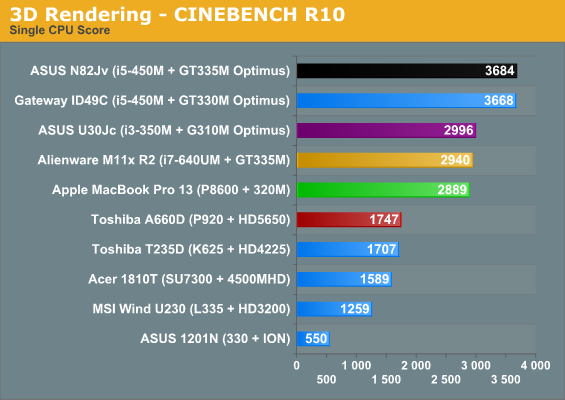
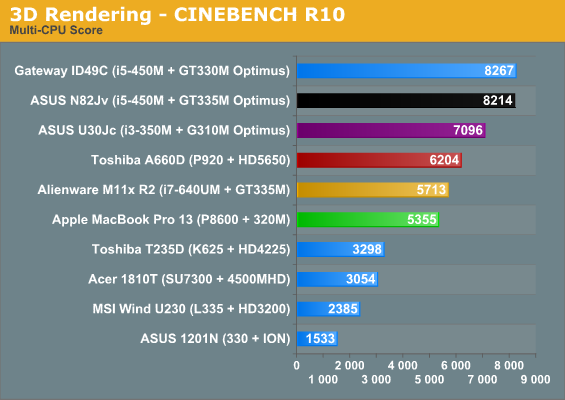
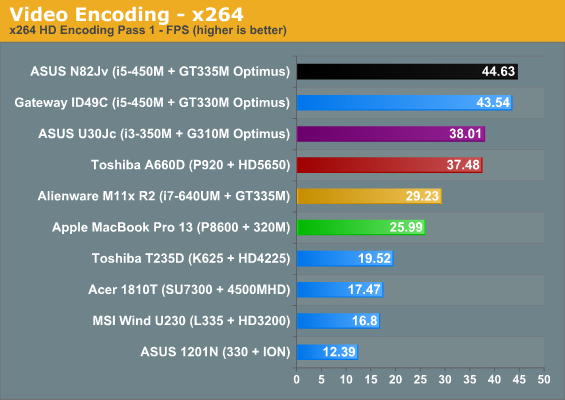
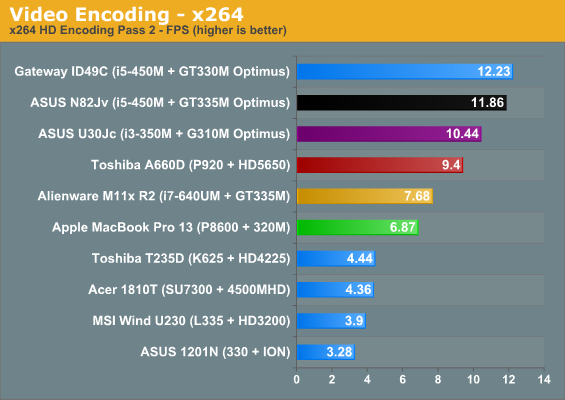
Here’s why it’s really sad: the MBP13 results would fit pretty well in our old Core 2 Duo notebook roundups, like this one from two years ago. The G50V and dv5t were $1200 notebooks back then, and they’re basically on par with the current MBP13. Quite frankly, it’s almost pathetic that Apple decided they could get away with a Core 2-based processor for another year at a price point that can get you a 14” aluminum unibody notebook with a quad core i7-720QM (HP, we’d still like to test an Envy 14, thanks). People expect Macs to cost more almost by default, but after a couple of years of the MBP13 being a decent value for a premium quality notebook (look at the old Envy 13 for comparison), it’s particularly jarring now to see it be so far behind the competition. I have none of these complaints for the Core i5/i7 sporting 15” and 17” models, however.
At this juncture, any notebook with a Core i3 can outrun the MBP. Same goes for the Core i7 ULV chip. We’ve never tested a Core i5 ULV, but we'll see the Core i3 ULV in a review shortly and it's in the same ballpark as Core 2—and the overclocked Core i3-330UM in the ASUS UL80Jt is basically on par with the MBP.
There are two ways you can look at this; you can say that at this point, anything with a Core 2 (even an old Merom) is more than powerful enough to run Windows and handle any reasonable task a thin and light notebook might be asked to. A lot of Apple fans say that. There’s another camp that says it’s completely unreasonable for Apple to sell a notebook with a Core 2 Duo processor at $1200, regardless of what it might be asked to do—there are smaller, thinner, lighter systems that perform better in basically every way. A lot of anti-Apple fans say that. They’re both right.
The Core 2 Duo is most certainly adequate to handle the normal, every day rigors of a portable notebook, but that’s not a reasonable justification for Apple selling a notebook that is more expensive than more powerful competitors. Apple is getting a bargain price on P8600 CPUs and the 320M chipset, which means the Core 2 + 320M is more about increasing profit margins than anything else. (And for those people who still cling to the theory that Apple couldn’t fit a third chip onto the board without reducing the battery size or making the notebook larger, that’s nonsense. If ASUS can manage to fit a Core 2010 processor, the chipset, and a dedicated graphics card into a system with similar dimensions to the MBP13 and a 33% larger battery, then Apple could have too. Simple as that.)
While we're here, we also ran all the 3DMark suites. This hints at the Core 2 + 320M combination being a lot more impressive than the above results, but then why couldn't Apple get GT 320M or faster with switching graphics into the system instead? Oh, right: that's only for 15" and 17" MBP. More on this when you hit the next page.
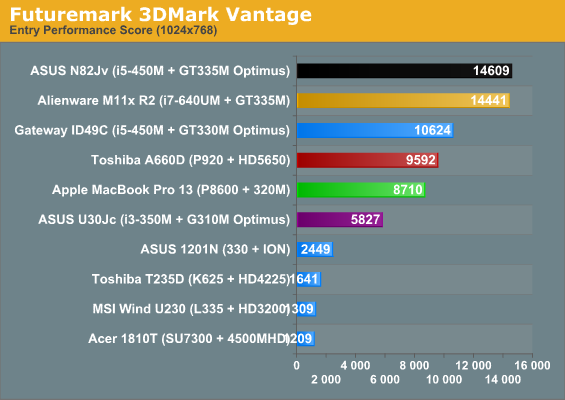
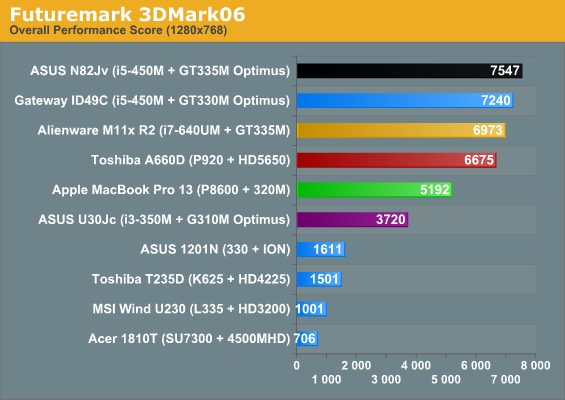
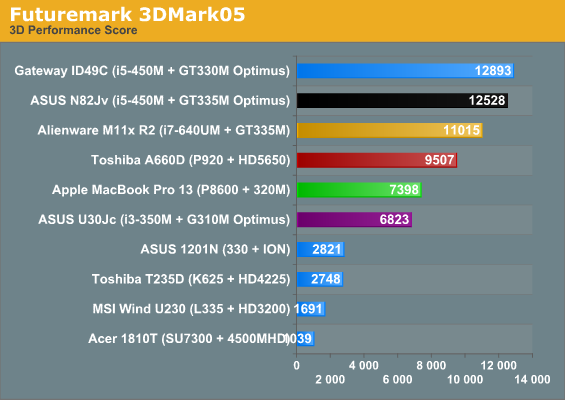
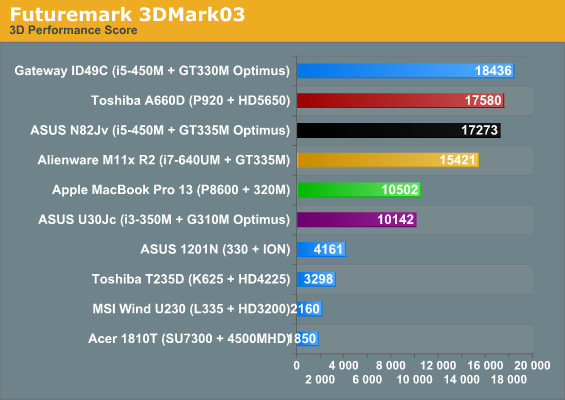
Okay, 320M looks decent, but the CPU is still old. We'll get into the graphics stuff on the next page, but while we're here looking at 3DMarks, we do have a quick question: how many of you want us to continue posting 3DMark results with our laptop reviews? We know they're a consistent point of reference for the long-term, but 03 and 05 in particular are getting very long in the tooth. So, if you want to sound off in the comments, would you like us to ditch 3DMark entirely, keep 06 and Vantage, keep all four like we've got above, or only skip 03/05?










117 Comments
View All Comments
seapeople - Wednesday, October 20, 2010 - link
The entire argument that "Macs have to be more expensive because Apple has to pay for..." is a moot point, because Apple makes GOBS of money off EVERYTHING they sell, especially including Macbook Pros. Macs are more expensive than PC's marginally because they cost more to make, but substantially because Apple simply has a product/brand name combination so desirable by people that they can sell it at huge price markups.To summarize: yes, there is a good reason that Macs are more expensive than PC's... it's because Apple likes to make money, and who can blame them? If you buy a $1500 laptop from Dell, you get ~$1400 of premium hardware crammed into a cheap plastic case with barely adequate build quality that trades quality for cheapness in every place you can see just so Dell can squeeze a $50 margin out of the machine and stay afloat through their mass marketing ability, whereas if you buy a $1500 laptop from Apple you get ~$700 of hardware fitted with top of the line externals including a unique and beautiful aluminum-alloy chassis, premium screen, and best-in-class touchpad that allows Apple to pull down a $500 margin and remain as the only company in the world with no debt. The Dell machine appeals to value-hungry tecno-inspired nerds who can give you the exact model number of the processor in their cheap plastic-looking machine, while the Apple machine appeals to normal people who don't necessarily know why their new shiny computer doesn't have a right click option but they're too embarrassed to ask and so just ignore it.
zefyr - Thursday, October 14, 2010 - link
I would really like to see you include the HP envy 14 in your comparison. Of all the pc laptops i think its the most comparable.VivekGowri - Thursday, October 14, 2010 - link
If you can get HP to send us one, we'd certainly include it. We've to date been unable to get HP to respond to our request for a review unit, so that ball is squarely in their court, not ours.Friendly0Fire - Sunday, October 17, 2010 - link
I'm pretty sure this might have to do with their supply issues with the Radiance screen.To be honest, I find these Mac articles a little useless and yes, biased, if you don't include the direct competition to them. I'm not buying an Asus for a stylish aluminum body or a super-high quality display, I'm buying one because it offers tremendous bang for your buck, great performance and acceptable quality. If I wanted a Mac and looked at options similar to it, I'd bring up a Vaio Z and an Envy 14 and then I'd make a strict comparison between the three. Both of those laptops would most likely utterly trash the Macbook Pro 13 and even then 15.
It's obvious that comparing a BMW to a Hyundai, the BMW will win (well, as long as price isn't a factor, which it of course isn't here). It isn't as obvious if you also get the Mercedes and the Lexus in the mix.
I understand that you don't have the bazillions that'd be required to buy out and test every laptop around, yet I can't shake the feeling that you're putting out a grossly wrong picture that only casts Apple in a near-godly figure, which annoys the hell out of me. If other, comparable choices are available for less money, it's just doing the consumer a disservice not to clearly mention it.
Thermogenic - Thursday, October 14, 2010 - link
Why not let the Alienware use it's 335M?VivekGowri - Thursday, October 14, 2010 - link
That's just a quirk in the graph's labeling, I think. I'm pretty sure Jarred didn't artificially limit the Alienware's performance when he tested it.JarredWalton - Friday, October 15, 2010 - link
Sorry, my mistake on a few charts. I retested the M11x R2 using the IGP at one point to show how it compared with the AMD HD 4200 IGP. Those results were put in the application charts, which changed the scores in PCMark and 3DMark (particularly in the latter). I've updated the charts with the correct 335M scores. Thanks for the catch!Focher - Thursday, October 14, 2010 - link
What I find interesting in the review - which was quite thorough and fair - is that the "value" part really came down to only the price-to-CPU comparison. In reading your section about the display, you castigate other manufacturers for cutting corners (and costs) on the display quality and compliment Apple. It seems Apple made the same call, but opted for the higher quality display and the lower quality (in terms of processing power) CPU. I only would point out that even the review mentions that the processing power of the C2D CPU is more than sufficient for typical usage patterns.I will admit my bias that Apple's industrial design tends to have me at hello, and for raw processing power I would never consider a notebook anyway.
JarredWalton - Friday, October 15, 2010 - link
Here's the thing: the CPU and IGP should be going for a song these days, which means that the cost of all the hardware minus the chassis and LCD is significantly less than the competition. Take the $1000 ASUS N82Jv and put the MBP13 chassis and LCD in there, and by all means it's a $1200 laptop that we'd happily recommend. (That would be $100 extra for the LCD, and $100 extra to make the chassis better.) Unfortunately, what Apple has done is to take something more like a $600 laptop, add in a good chassis and LCD, and they're charging $1200 for it.Based on the components, design, peripherals, etc., the MBP13 should go for more like $1000, and the standard MacBook could go for as little as $750, but of course Apple has no interest in lowering prices that far as long as people are willing to pay $1000 and $1200.
solipsism - Friday, October 15, 2010 - link
You’re only looking at a few aspects of the total product. Intel’s Price List doesn’t have the C2Ds being that much cheaper than the newer chips. Again, it seems like the lesser of two evils over using Core-i + IntelHD or sticking with C2D for a generation and having a better dGPU.I think too many companies focus only what can be marketed on a spec sheet and not what is useful for the average user. Anand readers are not the average user. This means compromises, just like a notebook-grade components cost more and are slower than desktop-greade components.
But the worst conclusion is determining what a product *should* go for by simply looking at a component or a few components of another product. Did you consider the cost of milling the aluminium chassis. Did you consider the cost of using green, recyclable materials and manufacturing methods (I don’t care about this but it does affect the cost)?
But most importantly, it doesn’t sound like you considered supply and demand? I know this a tech-based site but in business you sell a product at what the market can bare in order to maximize your profits. You don’t look at the same of a few parts of a competitor and then match their price regardless of profit. That’s asinine!
Let’s not forget that Apple has a “boutique”-like product line while most other big vendors have excessive model numbers. They simply can’t command the price point that Apple can. That doesn’t mean they are being altruistic;, they would get more profit from customers if they could.